#ancient Egyptian artifacts
Explore tagged Tumblr posts
Photo

Ahmes, “Scribe of accounts of gold” and “Overseer of the works of the god Amun”, kneels holding a stela with a prayer to the sun god Re.
Granite.
New Kingdom, 1550-1300 BC
National Museum of Denmark, Department of Classical and Near Eastern Antiquities
#history#historyblr#national museum of denmark#museum of denmark#history museums#history museum#museum#museums#egyptian history#egyptian artifacts#egyptian statues#stela#re#ahmes#egyptian scribes#amun#ancient egypt#ancient egyptian artifacts
23 notes
·
View notes
Text
Archeologists in Egypt discover 11 coffins that may 'reconstruct history'
Archeologists working in Egypt, where King Tutankhamun was found, have made a groundbreaking discovery that could “reconstruct history” as we currently understand it. Deep beneath Luxor, archeologists unearthed 11 wooden coffins, including one for a child, hidden within rock-cut tombs and burial shafts. In addition to the coffins, a treasure trove of artifacts was discovered, potentially shedding…
0 notes
Text
Author & Timestamp: Sarah Kuta for Smithsonian Magazine, April 30, 2024.
Note: this is an emotive topic and it is not one I feel qualified to give an opinion on yet. My sharing of this extract and link neither supports nor argues against any particular viewpoint, it's simply to take note of a conversation that I feel is important.
Extract:
[T]he Chau Chak Wing Museum at the University of Sydney [has] removed fragments of mummified bodies from public display. Museum staffers also plan to rename the “Mummy Room” to more accurately and respectfully reflect mummification’s significance in ancient Egyptian culture.
[...]
Egyptologist Melanie Pitkin, [...] a senior curator of antiquities and archaeology [at Chau Chak Wing], is leading the charge to rethink how the museum displays and interprets its Egyptian collection.
[...]
“For hundreds of years, body parts in museum collections have been treated as objects,” says Pitkin in a statement. “We have become so accustomed to seeing them on show that we often forget they once belonged to living people.”
For now, the remains are being kept in the museum’s “closely monitored collection store” while curators work to “implement better practices with Egyptian communities and authorities,” according to the statement. In the display, the museum replaced the unwrapped body parts with ancient Egyptian funerary portraits from coffin lids and masks. Curators are also exhibiting a painted portrait from the Roman era.
[Two] completely wrapped, mummified bodies [...] along with 3D visualizations based on CT scans of the remains. The CT scan data of another mummified body [...] also remains on view.
[...]
“In renaming the room, we’d like to focus more on the transformation of the body into an eternal being [...], rather than the body itself,” Pitkin says [...]. “We also encourage visitors to critically reflect on the ethical complexities museums face when caring for human remains.”
[...]
“[Modern] cultural stereotyping [of ancient Egyptian mummified bodies] would elsewhere be recognized as a form of racism, but the ancient Egyptians are not here to object to the ways in which we depict them,” Jasmine Day, an Egyptologist [...], tells the Sydney Morning Herald.
[...]
Around the world, curators and policymakers are also reconsidering their approaches to other types of artifacts. Earlier this year, [...] Harvard University removed a book binding made of human skin from its library, while the Field Museum in Chicago covered some of its Native American artifacts.
/end of extract
#important discussions#academic debate#museum politics#curation#mummified human remains#human remains#history#ancient#archaeology#museum news#Chau Chak Wing Museum#University of Sydney#Australia#mummified bodies#ancient Egyptian#museum displays#ancient Egyptian artifacts#museum collections#egyptology#antiquities#curators#academic ethics#ethics#mummification#Egyptian mummified remains#ethical considerations#ancient Egypt#cultural stereotyping#smithsonian#academic discourse
1 note
·
View note
Text
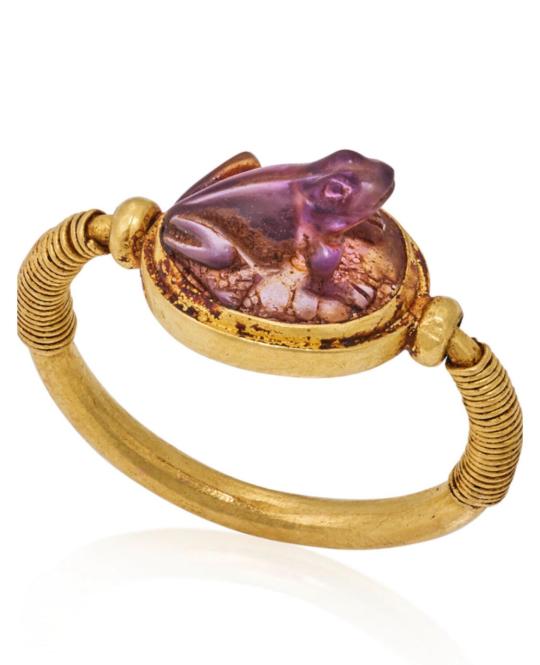
Gold swivel ring featuring an amethyst frog, from the New Kingdom period of Egypt, dating between 1550-1229 BC.
#new kingdom#ancient egypt#egyptology#egyptian#egypt#frog art#frog#amethyst#purple and gold#gold jewelry#gold rings#egyptian history#egyptian archaeology#egyptian art#antique#antiquities#toya's tales#style#toyastales#toyas tales#art#ring#antique jewelry#world history#artifact#art history#swivel ring#amphibians#fashion#accessories
2K notes
·
View notes
Text
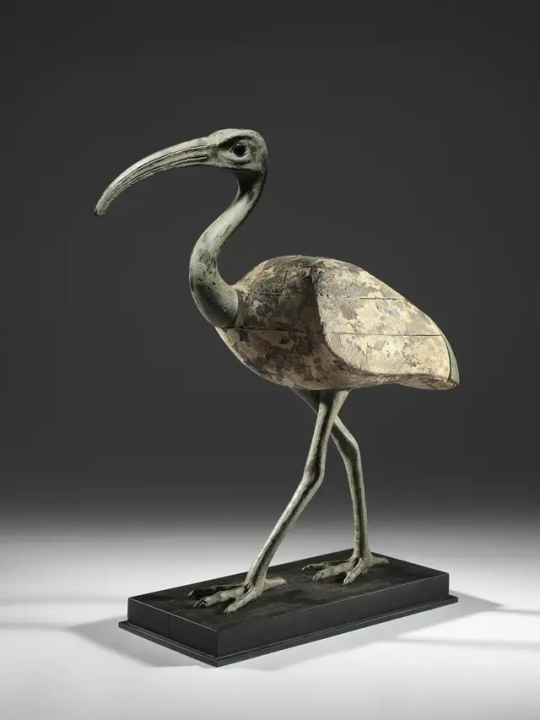
An Egyptian almost life-size bronze and wood striding ibis Late Period, circa 664-332 B.C.
#An Egyptian almost life-size bronze and wood striding ibis#Late Period#circa 664-332 B.C.#bronze#wood#ancient artifacts#archeology#archeolgst#history#history news#ancient history#ancient culture#ancient civilizations#ancient egypt#egyptian history#egyptian art#ancient art#art history
2K notes
·
View notes
Text
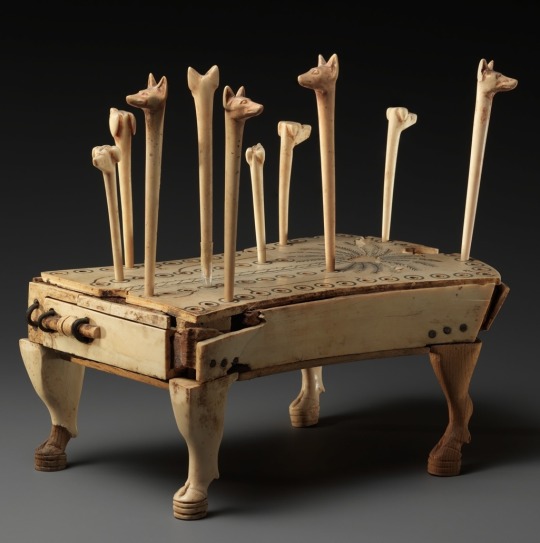
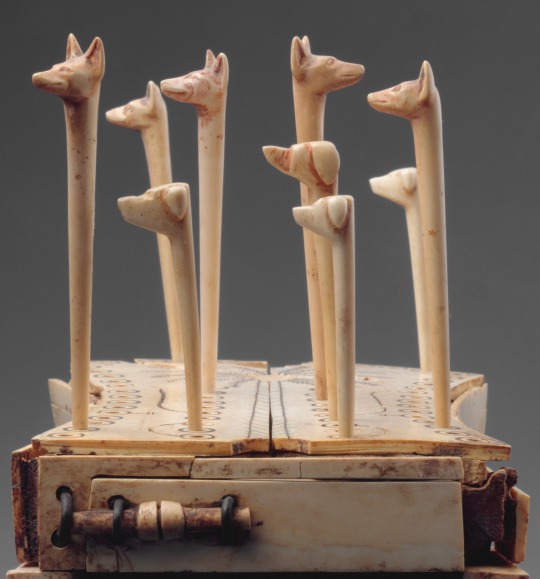
Egyptian
Game of Hounds and Jackals
Middle Kingdom, ca. 1814-1805 B.C.E.
#egyptian art#ancient egypt#ancient art#hounds and jackals#ancient history#artifact#antiquities#ancient people#ancient culture#egyptian history#egyptian culture#board games#chess#aesthetic#beauty#art history#aesthetictumblr#tumblraesthetic#tumblrpic#tumblrpictures#tumblr art#tumblrstyle#artists on tumblr#ancient artifacts
5K notes
·
View notes
Text

Ancient Egyptian faience emblem from a sistrum (rattle), depicting the goddess Hathor. Made by an unknown artist during the Late Period (Dynasties 26-29 = 664-332 BCE). Now in the Metropolitan Museum of Art. Photo credit: Metropolitan Museum of Art.
#art#art history#ancient art#Egypt#Ancient Egypt#Egyptian art#Ancient Egyptian art#artifact#artifacts#sistrum#Egyptian religion#Ancient Egyptian religion#Hathor#faience#Late Period#Metropolitan Museum of Art
214 notes
·
View notes
Text
2,000-Year-Old Fayum Portraits from Roman Egypt: also known as "mummy portraits," these funerary paintings were often fastened to the coffins of the people they depicted
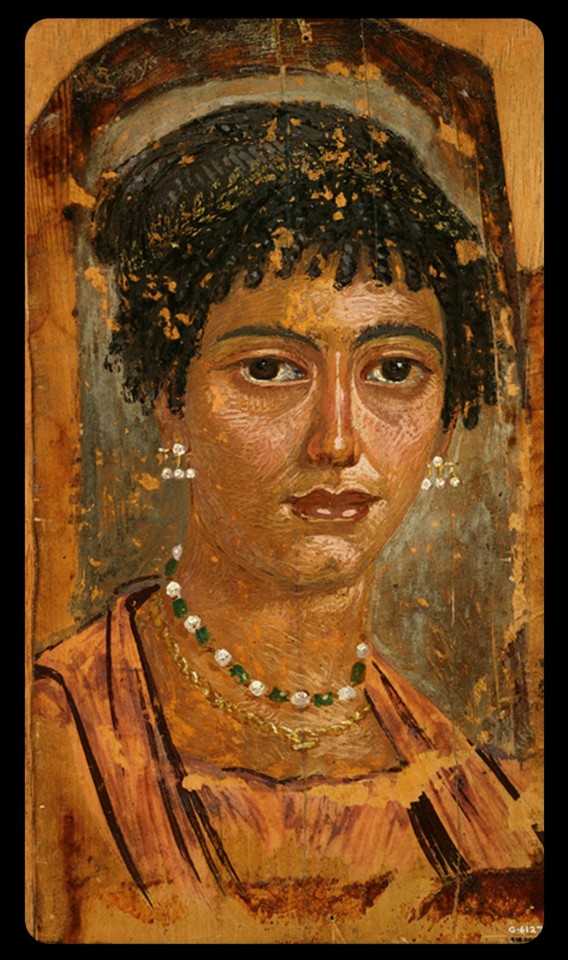
Above: Fayum portrait of a woman from Roman-occupied Egypt, c.100-110 CE
Fayum portraiture was a popular funerary practice among the upper-class families of Roman Egypt from about 50 CE to 250 CE. Given the high mortality rates for children during this period, many of these portraits depict children and youths, but adults were often featured, too.
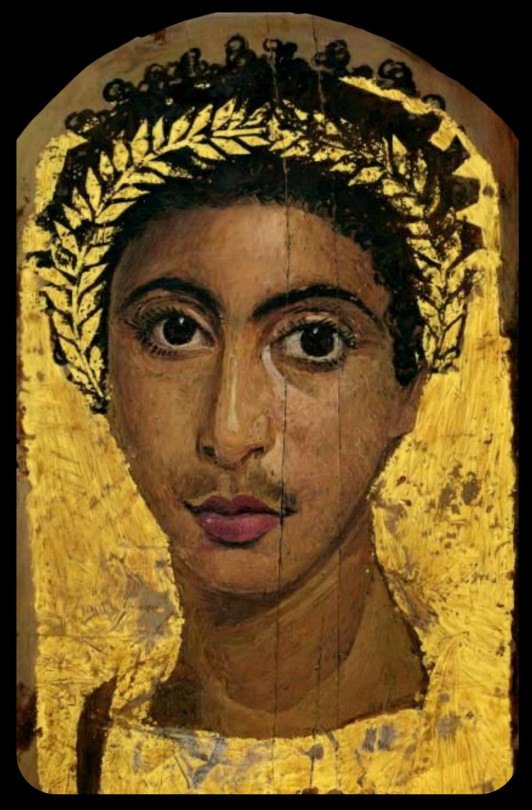
Above: portrait of a youth wearing a golden wreath, c.130-150 CE; the wreath and the background of the portrait are both gilded
The population of the Faiyum Delta, where most of these portraits were found, largely contained individuals with both native Egyptian/North African and Greek heritage. The Greek lineages can be traced back to the Ptolemaic period, when the Greeks gained control of Egypt and began to establish settlements throughout the region, gradually leading to a cultural diffusion between the Greek and Egyptian populations. The Romans eventually took control of Egypt in 31 CE, absorbing it into the Roman Empire and colonizing much of North Africa, but the demographics of the Faiyum Delta remained largely unchanged.
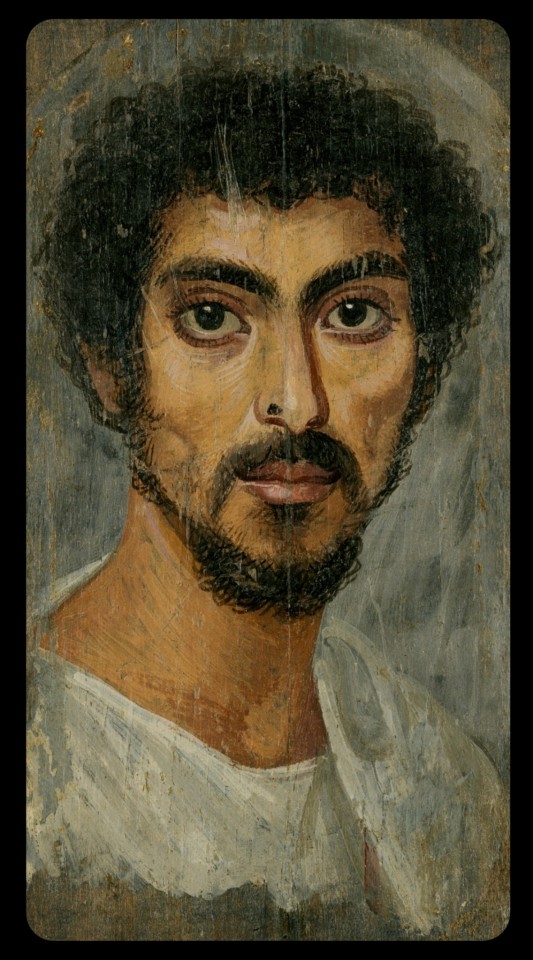
Above: portrait of a man with a mole on his nose, c.130-150 CE
Many of these Fayum portraits reflect the same blend of ethnic and cultural roots, depicting individuals with both Greek and native Egyptian heritage (a claim that is supported by both archaeological and genetic evidence). Some portraits may also depict native Egyptians who did not have any European ancestry, but had been integrated into Greco-Roman society.
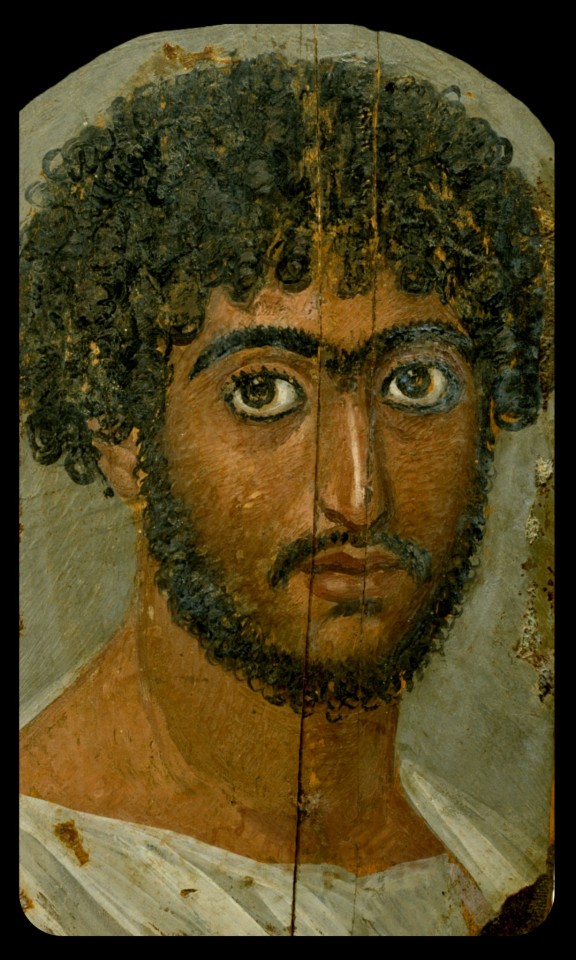
Above: portrait of a bearded man, c.170-180 CE
These representations of native Egyptians provide us with unique insights into the actual demographics of Roman-occupied Egypt (and the ancient world at large). Non-European peoples are rarely included in depictions of the classical world; it's also interesting to see the blend of cultural elements that these portraits represent.

Above: portrait of a priest of Serapis, c.140-160 CE; the man in this portrait is shown wearing a fillet/crown that bears the seven-pointed star of the Greco-Egyptian god, Serapis
As this article explains:
In the 1800s and early 1900s, Western art historians didn’t know what to make of these portraits. Scholars of Roman history labeled them Egyptian. Scholars of Egyptian history labeled them Greco-Roman. These binary academic classifications failed to capture the true complexity of the ancient (or, indeed, modern) Mediterranean. In reality, Fayum portraits are a syncretic form, merging Egyptian and Greco-Roman art and funerary practices. They reflect the cosmopolitanism of both Roman and Egyptian history.

Above: portrait of a man, c.80-100 CE (left); portrait of a bearded officer, sometimes referred to as "Perseus," c.130-175 CE (right)

Above: portrait of a young woman in red, c.90-120 CE
Nearly 1,000 of these portraits are currently known to exist.

Above: portrait of a man wearing a gilded ivy wreath, c.100-150 CE

Above: portrait of a bearded man, c.150-170 CE
Sources & More Info:
Curationist: Fayum Portraits
Harvard Art Museums: Giving the Dead their Due: an Exhibition Re-Examines Funerary Portraits from Roman Egypt
Getty Museum: APPEAR Project
Getty Museum: Faces of Roman Egypt
National Geographic: Ancient Egypt's Stunning, Lifelike Mummy Portraits
The Athens Centre: The Myth of Whiteness in Classical Sculpture
Forbes: Whitewashing Ancient Statues: Whiteness, Racism and Color in the Ancient World
#archaeology#artifact#anthropology#history#ancient history#art#fayum portraits#roman egypt#ancient rome#ethnography#painting#portrait#north africa#people of color#egypt#religion#greco roman#greek#classical antiquity#fayum#mummy portraits#romano egyptian#representation
413 notes
·
View notes
Text

What the pyramid of Khafre looked like 4,500 years ago compared to today. The pyramids of Giza were originally covered with highly polished white limestones, with the capstones at the peak being covered in gold
3K notes
·
View notes
Text
Hey. Don't cry. Ancient Egyptian jerboa figurines from ca. 1850 BC, ok?

#i was supposed to be writing a paper but I um. got distracted#by scrolling through 329 pages of the met's ancient egyptian collection to be specific#egypt#ancient egypt#antiquity#egyptology#stuff and things#artifacts
129 notes
·
View notes
Text








#Ramses II#Ancient Egypt#Egyptian army#artifacts#hieroglyphics#barracks#Ministry of Tourism and Antiquities#egyptian history#excavation#scarab beetle#burial site#Supreme Council of Antiquities#pottery#animal bones#hunting tools#accessories#bronze sword#history#culture#archaeology#archaeologists#mud bricks
24 notes
·
View notes
Photo

The pyramidion of the tomb of the “Priest of the Apis” Ptah-mose. The dead couple are praying to the sun gods Khepri, Re-Harakhte, and Atum.
Limestone.
New Kingdom, 1340-1290 BCE
National Museum of Denmark, Department of Classical and Near Eastern Antiquities
#denmark#history#historyblr#history museums#national museum of denmark#classical and near eastern antiquities#egyptian history#egyptian history exhibit#ancient egypt#ancient egyptian artifacts#ancient egypt exhibit#museums#museum
4 notes
·
View notes
Text
future archaeologists excavating our dumps, painstakingly sifting through plastic and soil for broken jewelry, mugs, beads, laminated paper, household bills, keys, guns, coins, rings, toys; people who love spoons, pennies, magnets, and rare license plates. specific object collectors of the world, rejoice! thy inheritants shall prosper
#you know how egypt is so ancient that ancient egyptians were excavating and studying even more ancient art and artifacts#i feel like people are gonna wanna lil peek in 200 years or so#they might give it 300 years…. shit would have to get totally buried and destroyed by natural disaster pompeii style to give it over 500#our technology lets our monkey brains discover shit faster than it can get forgotten
26 notes
·
View notes
Text

Egyptian Red Jasper and Gold Necklace, 22nd dynasty, 945-712 B.C. Composed of small round red jasper beads, interspersed with poppy seedpod pendants and gold amulets including lotus flowers, Tawerets, Hathor heads, a fly, a bird, and a falcon; strung with a modern closure. 16 in. (40.6 cm.) long x
#ancient jewelry#ancient art#antique jewelry#antique art#ancient egypt#egyptology#artifacts#archeology#uploads#red jasper#gold jewelry#necklace#egypt#egyptian art#north africa
20 notes
·
View notes
Text

Beautiful Egyptian Faience Hippopotamus (2040-1638 BC); Middle Kingdom, ancient Egypt.
This statuette of a hippopotamus (popularly called "William") was molded in faience, a ceramic material made of ground quartz. A glass-like material associated with rebirth, Egyptian faience was often used to make grave goods, such as this hippopotamus.
#faience#ancient egypt#egyptology#egyptian#egypt#hippopotamus#antique#artifact#antiquities#toya's tales#style#toyastales#toyas tales#art#november#fall#art history#animal art#ancient history#ancient art#ancient#egyptian art#middle kingdom#ceramics#quartz#turquoise#folk art#world history#ancient civilizations
271 notes
·
View notes
Text

Head of a cat Late Period–Ptolemaic Period, c. 664–30 B.C. The Met.
#Head of a cat#Late Period–Ptolemaic Period#c. 664–30 B.C.#cat#metal#metal sculpture#ancient artifacts#archeology#archeolgst#history#history news#ancient history#ancient culture#ancient civilizations#ancient egypt#egyptian history#egyptian art#ancient art
539 notes
·
View notes